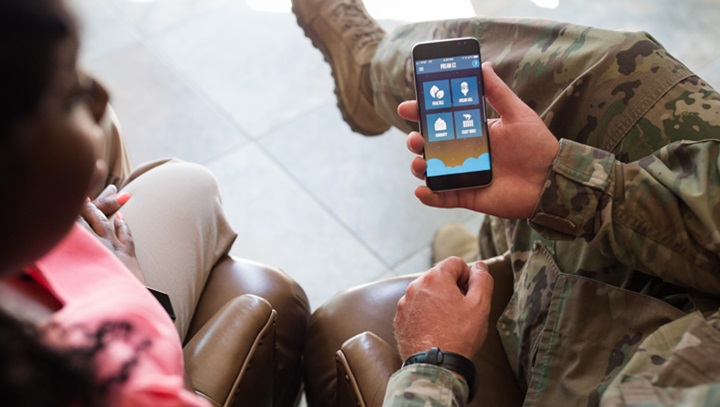11 January 2018
Development of a Virtual Hope Box
Applying smartphone technology to treat patients at risk of self-harm.
Military behavioral health patients experiencing distress and/or suicidal ideation are often separated from direct clinical support when they need it most, primarily due to service duties and/or a perceived stigma surrounding seeking behavioral and mental health care.
In an effort to increase coping skills and potentially lower suicidal ideation in military behavioral health patients, Research Psychologist Nigel Bush, PhD, in partnership with his colleagues at the National Center for Telehealth & Technology (T2), the Portland Veterans Administration (VA), and The Geneva Foundation, designed the Virtual Hope Box (VHB). The VHB is a multimedia, enhanced version of a conventional hope box delivered as a
smartphone application.
The conventional hope box is a key therapeutic tool used by clinicians to treat patients who express significant distress, suicidal ideation, or are otherwise at risk of self-harm. The box itself serves as a physical representation of the patient’s perceived reasons for living during times when they may be susceptive to suicidal thinking. The patient constructs and customizes the hope box to include reminders of previous successes, positive life experiences, existing coping resources, and current reasons for living.
The VHB expands upon the features of the conventional hope box by providing multimedia elements, including voice and video memos from loved ones, reminders of valued individuals and moments, stimuli that promote distraction, positive events scheduling, and audiovisual relaxation coaching and exercises.
The VHB was designed to be used by patients alongside ongoing treatment and as a way for patients to practice tailored coping techniques efficiently, conveniently, and privately. The VHB’s smartphone technology provides a variety of benefits to the patient. The smartphone offers a familiar, highly portable, and accessible platform widely used by service members and veterans, increasing its likelihood of use. This is especially critical for individuals who are highly emotionally reactive and/or engaged in suicidal thinking, as crises are most likely to emerge in the absence of healthcare providers.
Research study data collected at the Portland VA confirmed that high-risk veteran patients used the VHB regularly and frequently, found it easy to use, and reported that it was helpful and beneficial
in dealing with stress and emotional difficulties. Additionally, results indicated that the VHB significantly improved coping skills to stop unpleasant thoughts and emotions during the course of treatment compared to a control condition.
Users confirm that they use the VHB when they feel distressed or emotionally overwhelmed, and have spoken to the importance of the application being something private they can access, whether at home or in a crowded area. Since release to the Android and IOS marketplaces as a free application in March 2014, the VHB has been downloaded more than 250,000 times by users in more than a dozen countries and has received an unprecedented flood of positive endorsements and testimonials of benefit from providers and patients. Because it can be easily disseminated across a large population of users, the VHB may have broad, positive utility in behavioral health care


